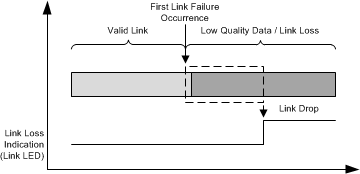ZHCSKM7I December 2019 – August 2025 DP83826E , DP83826I
PRODUCTION DATA
- 1
- 1 特性
- 2 应用
- 3 说明
- 4 模式比较表
- 5 引脚配置和功能(增强模式)
- 6 引脚配置和功能(基本模式)
- 7 规格
-
8 详细说明
- 8.1 概述
- 8.2 功能方框图
- 8.3
特性说明
- 8.3.1 自动协商(速度/双工选择)
- 8.3.2 自动 MDIX 分辨率
- 8.3.3 节能以太网
- 8.3.4 旧 MAC 的 EEE 不支持 802.3az
- 8.3.5 局域网唤醒数据包检测
- 8.3.6 低功耗模式
- 8.3.7 RMII 中继器模式
- 8.3.8 时钟输出
- 8.3.9 媒体独立接口 (MII)
- 8.3.10 简化媒体独立接口 (RMII)
- 8.3.11 串行管理接口
- 8.3.12 100BASE-TX
- 8.3.13 10BASE-Te
- 8.3.14 环回模式
- 8.3.15 BIST 配置
- 8.3.16 电缆诊断
- 8.3.17 快速链路丢失功能
- 8.3.18 LED 和 GPIO 配置
- 8.4 编程
- 8.5 寄存器映射
- 9 应用和实施
- 10器件和文档支持
- 11修订历史记录
- 12机械、封装和可订购信息
8.3.17 快速链路丢失功能
DP83826 包括高级链路丢失功能,可支持各种实时应用。链路丢失机制是可配置的,包含可实现极快链路丢失反应时间的增强模式。
DP83826 支持增强型链路丢失机制,也称为快速链路丢失 (FLD),可缩短用于确定链路的观察窗口。确定链路状态的方法有多种,可以根据用户偏好启用或禁用。
根据 DP83826 所处的模式,FLD 的默认状态会有所不同。在增强模式下,通过下拉 Strap7 来禁用 FLD 和所有检测机制。对于 EtherCAT 应用或启用了快速链路丢失功能并希望处理基线漂移数据包的应用,建议禁用信号能量检测,这可通过设置 Strap8 来实现。下表总结了由配置 (strap) 启用的模式。
| 搭接配置 | RX 错误计数 | MLT3 错误计数 | 低 SNR 阈值 | 信号/能量损耗 | 解码器链路丢失 |
|---|---|---|---|---|---|
|
Strap7 = LOW Strap1 = X Strap8 = X |
禁用 | 禁用 | 禁用 | 禁用 | 禁用 |
|
Strap7 = HIGH Strap1 = HIGH Strap8 = LOW |
启用 | 启用 | 启用 | 启用 | |
|
Strap7 = HIGH Strap1 = LOW Strap8 = LOW |
启用 | 禁用 | 启用 | 禁用 | |
|
Strap7 = HIGH Strap1 = LOW Strap8 = HIGH |
启用 | 禁用 | 禁用 | 禁用 |
在基本模式下,默认启用快速链路丢失功能。基本模式下的默认机制为 RX 错误和信号/能量损耗。
在两种模式下,可以使用控制寄存器 3(CR3,寄存器地址 0x000B)来配置 FLD。位 [3:0] 和位 [10] 允许启用各种 FLD 条件。当发生链路丢失时,可以从快速链路丢失状态寄存器(FLDS,寄存器地址 0x000F)读取特定故障条件的指示。
 图 8-9 快速链路丢失
图 8-9 快速链路丢失快速链路丢失标准包括:
- RX 错误计数 - 当在 10μs 窗口内发生预定义数量的 32 RX_ERs 时,链路被断开。
- MLT3 错误计数 - 当在 10μs 窗口内发生预定义数量的 20 MLT3 错误时,链路被断开。要使用基于 MLT3 错误的 FLD,请将寄存器快速链路丢失配置寄存器 1 (FLDCFG1,寄存器地址 0x0117)配置为 0x0417。
- 低 SNR 阈值 - 当在 10μs 窗口内发生预定义数量的 20 次阈值交叉时,链路被断开。
- 信号/能量耗损 - 当能量检测器指示能量损失时,链路被断开。
- 解码器链路丢失-当解码器失锁时,链路被断开。要使用基于解码器链路中断的 FLD,请将快速链路丢失配置寄存器 2(FLDCFG2,寄存器地址 0x0131)的位 [5:0] 配置为 0x08。
对于快速链路丢失功能,允许单独使用或以任意组合方式使用该等选项。